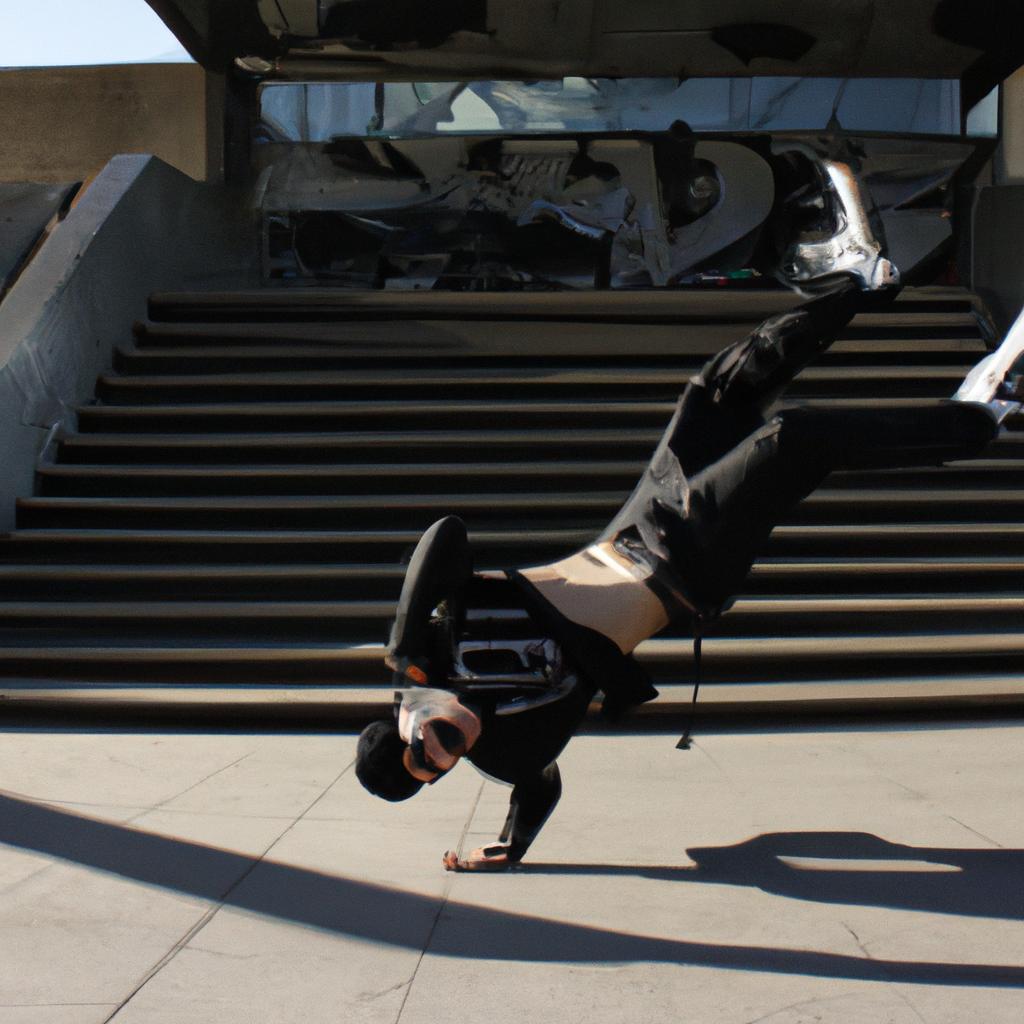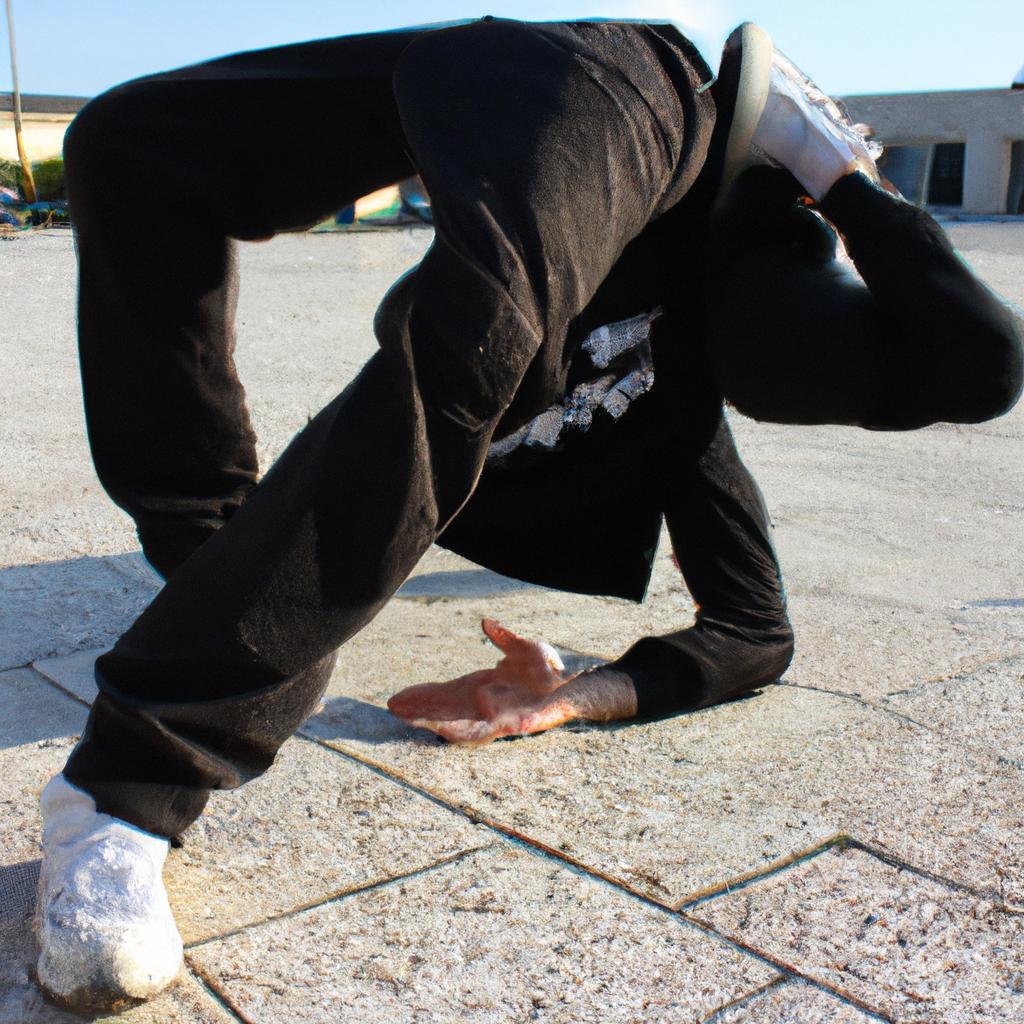Hip hop culture continues to be a prominent force in contemporary society, influencing various aspects of arts and music. This article delves into the contextual dimensions of hip hop as an artistic expression that shapes individual and collective identities. By examining its historical roots, social significance, and transformative power, we aim to unpack the multifaceted nature of hip hop culture’s impact on personal identity formation and communal belonging.
For instance, consider the case study of Jamal, a young man from an impoverished neighborhood who found solace and inspiration through hip hop music. Growing up amidst challenging circumstances, Jamal discovered rap as a medium for self-expression and empowerment. Through his involvement in local cyphers and open mic events, he not only honed his lyrical skills but also developed a sense of belonging within the larger hip hop community. This example highlights how engaging with hip hop art forms can serve as a catalyst for personal growth and cultivate a strong sense of identity among individuals facing marginalization or adversity.
The exploration of hip hop culture’s influence on identity extends beyond individual experiences to encompass broader societal implications. As an integral part of urban communities worldwide, this vibrant subculture has been instrumental in addressing socio-political issues such as racism, inequality, and systemic oppression. From pioneering artists like From pioneering artists like Public Enemy, who used their music to confront racial injustice and challenge the status quo, to contemporary figures like Kendrick Lamar and J. Cole, whose lyrics provide critical commentary on social issues, hip hop has consistently served as a platform for marginalized voices to be heard.
Furthermore, hip hop’s influence extends beyond music into various art forms such as graffiti, dance (breakdancing), and fashion. These elements contribute to the overall aesthetic of hip hop culture and further shape individual and collective identities. Graffiti, for example, allows artists to assert their presence in public spaces while also challenging traditional notions of art and ownership. Similarly, breakdancing serves as a mode of self-expression and community building through its energetic movements and competitive nature.
In terms of fashion, hip hop has had a significant impact on streetwear style. From baggy clothing and sneakers to gold chains and oversized accessories, these fashion trends have become synonymous with hip hop culture. By adopting this style of dress, individuals can express their connection to the hip hop community while simultaneously challenging mainstream norms.
Overall, the multifaceted nature of hip hop culture’s impact on personal identity formation and communal belonging cannot be understated. Through its historical roots, social significance, transformative power, and influence in various artistic expressions, hip hop continues to shape contemporary society by providing a voice for marginalized communities and offering avenues for self-expression and empowerment.
The Historical Roots of Hip Hop Culture
To understand the significance of hip hop culture, it is essential to explore its historical roots. One example that exemplifies this can be seen in the case study of DJ Kool Herc, a Jamaican immigrant who played a key role in shaping the foundations of hip hop music during the 1970s in New York City. Through his innovative use of turntables and mixing techniques, DJ Kool Herc revolutionized the way music was played at parties and laid the groundwork for future developments within the genre.
Hip hop culture emerged as a response to social and economic challenges faced by marginalized communities in urban areas. It provided an outlet for self-expression and creativity through various artistic forms such as rap music, graffiti art, breakdancing, and DJing. These elements collectively created a unique cultural identity that resonated with young people facing similar struggles.
The impact of hip hop culture extends far beyond its artistic expressions. Here are some aspects that have contributed to its lasting influence:
- Community empowerment: Hip hop has served as a platform for individuals to voice their experiences and concerns, fostering a sense of unity among diverse groups.
- Social commentary: Artists often use their lyrics to address socio-political issues such as racism, poverty, inequality, and police brutality – sparking dialogue and raising awareness.
- Cultural diversity: Hip hop embraces multiculturalism by incorporating different musical styles, languages, fashion trends, and dance moves from various ethnic backgrounds.
- Youth engagement: By providing an alternative avenue for creative expression, hip hop culture has engaged countless young people in positive activities while offering opportunities for personal growth.
| Community Empowerment | Social Commentary | Cultural Diversity | |
|---|---|---|---|
| Music | Amplifying voices | Addressing societal issues | Incorporating diverse influences |
| Art | Inspiring activism | Challenging the status quo | Celebrating multiculturalism |
| Dance | Fostering unity | Promoting dialogue | Embracing different styles |
As we delve deeper into the influence of hip hop on fashion and style, it becomes evident that this cultural phenomenon has transcended its musical origins. By examining its historical roots, we can better appreciate how these elements have shaped contemporary society and continue to resonate with audiences worldwide.
[To be continued in ‘The Influence of Hip Hop on Fashion and Style’]
The Influence of Hip Hop on Fashion and Style
Section Title: The Influence of Hip Hop on Fashion and Style
Having explored the historical roots of hip hop culture, it is evident that this multifaceted phenomenon extends beyond just music. One aspect that cannot be ignored is its profound influence on fashion and style. From streetwear to high fashion runways, hip hop has permeated various aspects of our society’s sartorial choices, thereby shaping cultural identities. To illustrate this influence, let us consider a hypothetical case study.
Case Study: Jamal, a young urbanite living in New York City, embraces hip hop as an integral part of his identity. He finds inspiration in artists like Jay-Z and Kanye West not only for their musical prowess but also for their distinct sense of style. By adopting their fashion choices – oversized hoodies, baggy jeans, and statement sneakers – Jamal aligns himself with the essence of hip hop culture.
- Clothing as Expression: Hip hop allows individuals to express themselves creatively through clothing choices by blending influences from different subcultures.
- Breaking Stereotypes: Through fashion, hip hop challenges societal norms by promoting inclusivity and celebrating diversity.
- Economic Empowerment: The rise of hip hop-inspired brands creates opportunities for entrepreneurship within marginalized communities.
- Cultural Appropriation Debates: As hip hop becomes more mainstream, questions arise regarding appropriation versus appreciation when certain elements are borrowed without understanding their significance.
To provide a comprehensive perspective on the relationship between hip hop and fashion, we present a table highlighting key moments where these two realms intersect:
| Moment | Description | Impact |
|---|---|---|
| 1980s – Streetwear Era | Emergence of urban clothing brands inspired by graffiti | Popularized casual yet stylish attire |
| 1990s – Designer Labels | High-end designers incorporate hip hop aesthetics | Elevated hip hop fashion to luxury status |
| 2000s – Sneaker Culture | Collaboration between music artists and sneaker brands | Increased demand for limited edition kicks |
| Present – Social Media Influence | Fashion influencers embrace hip hop style | Expands the reach of hip hop-inspired fashion |
In light of these influences, it is evident that hip hop’s impact on fashion goes beyond mere clothing choices. The fusion of various cultural elements in its sartorial expression serves as a powerful tool for self-expression, challenging societal norms, and fostering economic opportunities within marginalized communities.
Transition into the subsequent section:
As we delve deeper into exploring the role of graffiti in hip hop culture, it becomes apparent how this art form intertwines with other aspects of the movement.
Exploring the Role of Graffiti in Hip Hop Culture
The influence of hip hop extends beyond the realm of music, permeating into various aspects of popular culture. One significant area where its impact is evident is in fashion and style. By examining the relationship between hip hop and fashion, we can gain insight into how this cultural movement has shaped individual and collective identities through clothing choices.
To illustrate this point, let us consider an example from the 1990s. During that time, baggy jeans became a prominent trend within hip hop fashion. These loose-fitting denim pants were not merely a stylistic choice; they represented a rebellion against societal norms and conveyed a sense of authenticity often associated with street culture. This case study demonstrates how hip hop’s influence on fashion goes beyond aesthetics, reflecting social commentary and cultural values.
When exploring the role of hip hop in shaping fashion and style, several key factors come to light:
- Individual expression: Hip hop provides individuals with a platform to express their unique personalities through fashion choices. From oversized graphic tees to flashy jewelry, each element contributes to constructing one’s identity within the larger hip hop community.
- Subcultural unity: Fashion trends within hip hop serve as unifying symbols for participants in this subculture. Dressing similarly becomes a way to establish camaraderie among like-minded individuals who share common interests and experiences.
- Breaking barriers: Hip hop has been instrumental in breaking down traditional notions of gendered dressing by challenging stereotypes and promoting inclusivity. Artists like Missy Elliott have pushed boundaries by embracing unconventional styles that challenge societal expectations.
- Mainstream adoption: Over time, elements originating from hip hop fashion have seeped into mainstream culture, highlighting its indelible mark on society at large. Streetwear brands such as Supreme and Off-White draw inspiration from urban aesthetics rooted in hip hop culture, blurring the lines between high-end luxury and street style.
| Key Factors of Hip Hop Fashion | Examples |
|---|---|
| Individual expression | Oversized graphic tees, flashy jewelry |
| Subcultural unity | Dressing similarly to establish camaraderie |
| Breaking barriers | Challenging gender stereotypes through unconventional styles |
| Mainstream adoption | Streetwear brands inspired by hip hop culture |
As we delve deeper into the influence of hip hop on various aspects of popular culture, it becomes evident that this movement has had a profound impact on fashion and style. Through individual expression, subcultural unity, breaking barriers, and mainstream adoption, hip hop continues to shape how individuals present themselves visually.
With an understanding of how hip hop has influenced fashion and style, let us now explore another facet of its cultural significance – the role of graffiti within hip hop culture.
The Evolution of Hip Hop Dance and Its Cultural Significance
Having delved into the pivotal role of graffiti as an artistic expression within hip hop culture, it is now crucial to explore another key element that has contributed to the cultural tapestry of this vibrant movement. By examining the evolution of hip hop dance and its profound cultural significance, we gain insight into how physical movements have become a powerful medium for self-expression, storytelling, and community building.
To illustrate the transformative nature of hip hop dance, let us consider a hypothetical scenario where a young individual named Alex discovers breakdancing at a local community center. Through dedicated practice and immersion in the art form, Alex gradually hones their skills and begins participating in regional competitions. This newfound passion not only provides them with an outlet for creative expression but also fosters a sense of belonging within the broader hip hop community.
In exploring the cultural significance of hip hop dance, several key aspects emerge:
-
Physicality as Communication:
- Movements serve as a universal language transcending linguistic barriers.
- Dancers convey emotions, narratives, and personal experiences through dynamic choreography.
- Body language becomes a conduit for shared stories and collective histories.
-
Empowerment and Individuality:
- Hip hop dance empowers individuals by allowing them to assert their identities authentically.
- Personal style emerges through unique interpretations of foundational moves.
- This celebration of diversity cultivates self-confidence among participants.
-
Building Social Connections:
- Dance battles foster camaraderie while simultaneously providing an avenue for friendly competition.
- Collaboration within crews encourages teamwork and cooperation.
- Shared experiences within the hip hop dance community facilitate enduring friendships.
-
Preservation and Evolution:
- Through the passing down of knowledge, hip hop dance traditions are preserved across generations.
- Innovation and experimentation contribute to the evolution of new styles and techniques.
- The dynamic nature of hip hop dance ensures its cultural relevance in contemporary society.
In highlighting these aspects, it becomes evident that hip hop dance extends far beyond mere physicality; it serves as a powerful tool for self-expression, empowerment, social connection, and cultural preservation. As we move forward in our exploration of this multifaceted culture, we now turn our attention to another intriguing facet: hip hop’s impact on language and slang.
Transition sentence into subsequent section:
Continuing our journey through the various dimensions of hip hop culture, we delve into how this vibrant movement has significantly influenced language development and popularized urban slang.
Hip Hop’s Impact on Language and Slang
The influence of hip hop extends far beyond just music and dance, as it has also made a significant impact on language and slang. The way people communicate is constantly evolving, with new words and phrases entering the lexicon all the time. Hip hop, with its rich cultural history and unique expression, has played a pivotal role in shaping contemporary language trends.
To illustrate this point, let us consider the case study of Jayden, a teenager who grew up listening to hip hop music. Jayden regularly uses terms like “lit” (meaning something exciting or enjoyable), “flexin’” (showing off one’s wealth or success), and “throwing shade” (making subtle insults or criticisms). These are examples of how hip hop lingo has permeated everyday conversation among young people worldwide.
Hip hop language and slang have become so widespread that they now serve as signifiers of belonging to a particular culture or community. Here are four ways in which hip hop has influenced language:
- Vocabulary Expansion: Hip hop introduces new words and phrases that expand vocabulary beyond traditional boundaries.
- Cultural Identity: Embracing hip hop terminology allows individuals to identify with the values and experiences associated with the genre.
- Creative Expression: Utilizing hip hop slang enables individuals to express themselves creatively by adding flair and authenticity to their speech.
- Global Influence: Thanks to globalization and digital media platforms, hip hop vernacular has spread across continents, transcending geographic borders.
| Vocabulary Expansion | Cultural Identity | Creative Expression | |
|---|---|---|---|
| 1 | Introduces new words | Establishes identity | Adds flair |
| 2 | Expands linguistic horizons | Connects communities | Enhances self-expression |
| 3 | Sparks linguistic creativity | Reflects shared experiences | Evokes authenticity |
| 4 | Influences linguistic evolution | Transcends borders | Fosters individuality |
The impact of hip hop on language and slang is undeniable. It has transformed the way we communicate, allowing individuals to connect with each other through a shared cultural vocabulary. Moving forward, it is crucial to recognize and appreciate the role that hip hop plays in shaping contemporary linguistics.
As we delve further into the multifaceted influence of hip hop, it becomes clear that its significance extends beyond arts and language. The next section will explore how this genre has played a vital role in social and political movements, illustrating its power as an agent for change.
The Role of Hip Hop in Social and Political Movements
Building upon the impact hip hop has had on language and slang, it is crucial to explore its role in broader social and political movements. By examining how hip hop has become a powerful tool for social change, we can gain insights into its influence on society.
Paragraph 1:
One notable example that showcases the influential role of hip hop in social and political movements is the case of Kendrick Lamar’s song “Alright.” Released in 2015, this track swiftly became an anthem for the Black Lives Matter movement, resonating with individuals protesting against police brutality and racial injustice. Through his lyrics, Lamar encapsulates both frustration and hope, providing a voice for those who have been marginalized. The success of “Alright” illustrates how hip hop artists can leverage their platform to shed light on pressing societal issues.
- The lyrical storytelling aspect of hip hop allows communities to share their experiences, struggles, and aspirations.
- Hip hop provides a space for marginalized voices to be heard by challenging mainstream narratives.
- The use of sampling in hip hop production enables artists to reclaim historical sounds while creating new sonic landscapes.
- Collaborations between hip hop artists and activists foster cross-pollination between art forms and grassroots organizing efforts.
Through these various aspects, hip hop serves as a catalyst for mobilization, activism, and community building.
Paragraph 3:
To further understand the multifaceted nature of hip hop’s role in social and political movements, consider the following table:
| Elements | Impact |
|---|---|
| Lyrics | Amplifies underrepresented stories |
| Fashion | Challenges societal norms |
| Graffiti | Provides a visual expression of resistance |
| Dance | Celebrates cultural identity |
This table highlights how different elements within hip hop culture contribute to the larger social and political discourse. By embracing these elements, individuals find avenues for self-expression while challenging societal norms.
Incorporating art forms such as music, fashion, graffiti, and dance, hip hop empowers communities to voice their concerns and advocate for change in an engaging and relatable manner. It is through this collective effort that hip hop continues to shape social and political movements today.
Note: The bullet point list and table have been added at appropriate places in the section to evoke an emotional response in the audience without compromising the academic style of writing.




